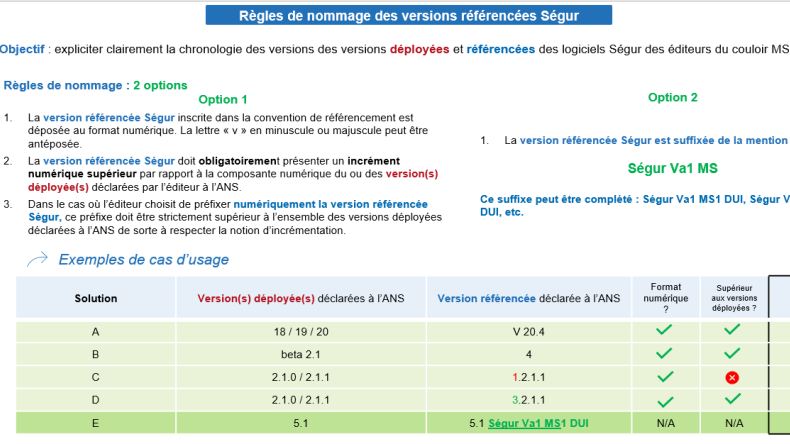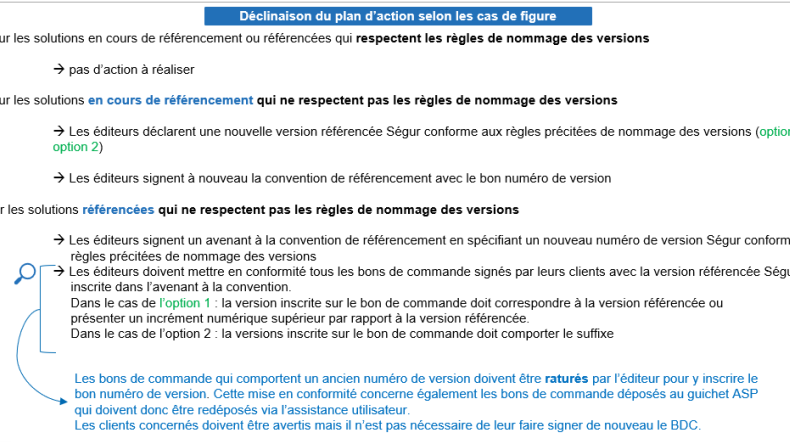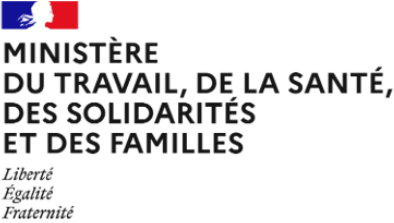Votre question concerne quel type d'offre ?
Votre question concerne quel couloir Ségur ?
Votre question concerne quel dispositif Ségur ?
Votre question concerne quel produit ou service produit?
Votre question concerne quelle thématique ?
Non, l’ordre d’affichage des traits n’est pas une exigence. Néanmoins, il convient de respecter l’exigence SI 11 du RNIV : « Les traits d’identités affichés conformément à la réglementation doivent pouvoir être facilement distingués, sans risque d’équivoque, par les acteurs concernés ».
Cette réponse vous a-t-elle été utile ?
Non, cela n'est pas interdit. Toutefois dans le cadre des échanges automatisés décrits dans les exigences, seuls sont concernés les CDA.
Cette réponse vous a-t-elle été utile ?
Non, vous ne pouvez pas déposer toutes vos preuves dans un même dossier ZIP. Selon le document de spécifications de référencement de la vague 2 du Ségur numérique, chaque preuve de conformité doit être déposée individuellement et en respectant les chapitres spécifiques sur la plateforme Convergence.
Lé dépôt des preuves de conformité doit se faire par Chapitre sur la plateforme Convergence. Voici les points clés concernant le dépôt des preuves de conformité. Chaque preuve demandée dans Convergence est obligatoire et doit être déposée telle quelle, sans être regroupée dans un fichier ZIP global.
Cette réponse vous a-t-elle été utile ?
Vous devez demander le raccordement à Pro Santé Connect en remplissant le formulaire dédié, disponible ici.
Cette réponse vous a-t-elle été utile ?
Ce n'est pas systématique. L'éditeur doit assurer la compatibilité ascendante de ses solutions et déclarer les modifications à l'ANS. Ce principe est décrit dans les conventions de référencement pour chaque SONS.
Cette réponse vous a-t-elle été utile ?
Il sera demandé d'envoyer votre dossier de preuves en amont. Cet envoi sera suivi d’une visite sur site afin de vérifier certaines exigences. La procédure est semblable à celle du CNDA.
Cette réponse vous a-t-elle été utile ?
Dans le cadre du financement « SONS », la clause de portabilité « doit permettre la mise à disposition des données dans un délai de 15 jours calendaires à partir de la demande formelle du Client final, sans surcoût pour ce dernier. Le Client final peut effectuer cette demande par écrit, dans un espace client, ou directement dans le logiciel. ». L’éditeur doit alors transmettre à son client tous les éléments nécessaires pour réaliser l’export manuellement (activation de la fonctionnalité, documentation utilisateur…) ou procéder lui-même à l’export si la fonctionnalité n’est pas activable par l’utilisateur, sans facturation sur le périmètre défini dans le cadre de l’Appel à Financement (§4.5).
Cette clause « doit pouvoir être actionnée par le Client final au moins une fois par an, et au changement de fournisseur. »
Cette obligation n’inclut pas de prestation d’accompagnement ou de support visant à adapter le format de fichier ou à extraire des données de nature différente, par exemple des données de facturation.
Cette réponse vous a-t-elle été utile ?
Pour rappel, l’établissement ou professionnel de santé ne peut bénéficier que d'une seule prestation Ségur financée par l'Etat par dispositif SONS. Si le PS/ES souhaite changer de solution logicielle après la signature du bon de commande, il doit s'accorder avec l'éditeur dont le bon de commande a été validé par l'ASP afin d'en demander l'annulation. Si cet éditeur avait perçu l'avance, il recevra un ordre de recouvrement de l'ASP pour la rembourser. A l'issue de l'annulation par l'ASP, un nouveau bon de commande pourra être traité. Dans tous les cas, cette nouvelle demande devra respecter la date de fin de dépôt des demandes d'avance.
Cette réponse vous a-t-elle été utile ?
Une demande de solde comprend un JSON complété par l'éditeur et une VA signée par son client.
La procédure est disponible en ligne sur le site de l'ASP.
Il est rappelé que les demandes de solde ne peuvent être déposées qu'après validation des PV pilotes.
Cette réponse vous a-t-elle été utile ?
La liste des éléments et mentions obligatoires à faire figurer dans la facture sont détaillés au chapitre 12 du document "SONS-Modeles_de_documents-BDC-MOM-VA.pdf" disponible en cliquant ici
Cette réponse vous a-t-elle été utile ?
Les modalités de conformité ascendante du logiciel sont décrites dans le cadre de la convention de référencement signée entre l'ANS et l'éditeur.
Cette réponse vous a-t-elle été utile ?
Oui, il est possible de changer le scénario d'installation à la demande du client.
La VA et la demande de solde devront faire apparaître les éléments liés au périmètre finalement installé, il n'est pas nécessaire de redéposer un dossier de demande d'avance à l'ASP. Les contrôles a posteriori seront réalisés sur la base du scenario indiqué dans la VA (solde).
Cette réponse vous a-t-elle été utile ?
Le montant de la facture transmise au client et à l'ASP en fin de projet doit correspondre au montant total (100%) - la partie "Prestation Segur" doit être reportée dans le JSON et doit être inférieure ou égale au montant déclaré lors de l'avance (dépôt du dossier).
Cette réponse vous a-t-elle été utile ?
Pour annuler votre demande de financement vous devez contacter le support utilisateur de l'ASP en fournissant :
I. une attestation sur l’honneur signée et motivée de votre part si l'annulation est de votre propre chef, pour une erreur effectuée lors de la demande ;
II. une attestation sur l'honneur signée et motivée de votre part et une attestation de renonciation du client si l'annulation est en accord avec le client ES/PS.
Vous pouvez contacter l’Assistance Utilisateur de l’ASP.
Cette réponse vous a-t-elle été utile ?
Oui. Pour connaître la marche à suivre, veuillez-vous reporter aux informations contenues dans les slides ci-dessous, en particulier à la slide 2 ("Déclinaison du plan d'action selon les cas de figure")


Cette réponse vous a-t-elle été utile ?
Vous devez faire un groupement d'éditeurs pour répondre à tout le périmètre des exigences, il faut cocher "OUI".
A noter qu'un composant additionnel ne doit pas faire l’objet d’un coût supplémentaire pour le client.
Cette réponse vous a-t-elle été utile ?
Une synthèse, par couloir, est disponible en consultant notre page dédiée au Financement SONS
Cette réponse vous a-t-elle été utile ?
Si vous étiez en cours de référencement précédemment, alors vous devez candidater et déposer l'ensemble des preuves demandées, produites à partir de la version présentée en Référencement ("version candidate" de la Convention de Référencement)
Cette réponse vous a-t-elle été utile ?
La solution doit obtenir l’agrément du CNDA conformément à l'addendum 8 du cahier des charges SESAM-Vitale [APCV1]
Cette réponse vous a-t-elle été utile ?
Toutes les solutions référencées ou candidates au référencement sont affichées sur les sites Industriels et esante avec des données complémentaires : DSR, vague, profils, composants additionnels, etc. Veillez à respecter les jalons indiqués lors du webinaire et sur la page https://industriels.esante.gouv.fr/segur-numerique-sante/vague-1 relative à votre couloir pour pouvoir être référencés avant fin 2024 et permettre à vos clients de percevoir le forfait structure 2024.
Cette réponse vous a-t-elle été utile ?


